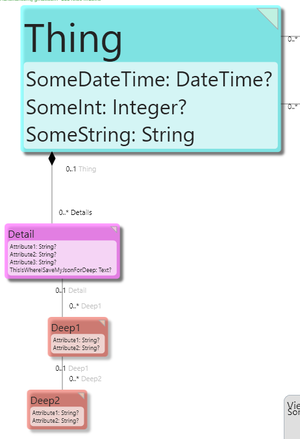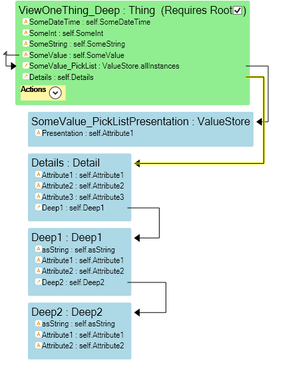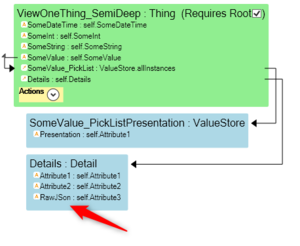Hans Karlsen (talk | contribs) No edit summary |
Hans Karlsen (talk | contribs) No edit summary |
||
| Line 63: | Line 63: | ||
To handle this we make use of the RawJSon attribute in a new ViewModel like this: | To handle this we make use of the RawJSon attribute in a new ViewModel like this: | ||
[[File:2019-09-09 21h59 55.png|none|thumb]] | [[File:2019-09-09 21h59 55.png|none|thumb]] | ||
If we now import with ViewOneThing_SemiDeep we get a result that looks like this: | If we now import with ViewOneThing_SemiDeep we get a result that looks like this (when we read it back with AsTajson): | ||
<pre> | <pre> | ||
{ | { | ||
| Line 76: | Line 76: | ||
} | } | ||
</pre> | </pre> | ||
We can now - in a separate pass - loop through a chunk of "Detail"-objects that has a JSon data structure in its Attribute3 - and run ApplyTajson with this snippet of json. This will give a worker - like the MDrivenServer ServerSideJobs plenty of small pieces to work on over an extended time, one by one. And this is a much better way to handle the case of large datasets that could result in billions like 1000*1000*1000. | |||
Read more on usage in [[Rest Services In MDriven]] | Read more on usage in [[Rest Services In MDriven]] | ||
Revision as of 20:06, 9 September 2019
TaJson is a declarative approach to receive, send, transform and store json messages, with setup and maintenance environment done in minutes
You can find the original introduction of TaJson here: https://blog.mdriven.net/introducing-mdriven-tajson/
Creating Json from objects
Easiest is to use AsTaJson to create a Json object graph using a viewmodel as a template.
Creating objectsfrom Json
Given a Json object iterates attributes and associations - matching names in a VMClass-instance, and updates internal hierarchy of VMClass given first attribute as key
The RootObject must be given to the VMClass, after that the json object updates hierachy below.
To facilitate update we look for special things in the ViewModel:
- Action ViewModelColumn_AddNew will be used to create new objects needed for viewmodel-association with name ViewModelColumn - Action must return created object - if action is not found we will look at type info and create object. Note! the AddNew action MUST add the object to the association.
- Action Delete in nesting will be used if found when we need to delete object due to missing in input and merge mode is not in effect
- Variable vImportKey:string if found will be updated prior to creating a object - can be used in the _AddNew action to look up existing object
- Action CleanUpAction if found on root ViewModelClass will be called after the import is finished
When using MergeTaJson and ApplyTaJson they both return a string (large) with a log of the Merge/Apply -log.
Extension implemented 201909
When confronted with very large and deep json structures it may be a good idea to split the processing and object creation into multiple smaller parts.
Especially the resolve and set of single links may prove problematic to do for a large number of leaf nodes in a large structure.
To facilitate such splitting of large work into smaller pieces we now allow for a special attribute in TaJSon import (Merge and Apply), the special attribute is RawJSon:string (case sensitive).
When the logic finds a ViewModelColumn named RawJSon in a ViewModel nesting - the current Json text is inserted as a string - this is the JSon for the current level and below.
Example:
Consider this Json:
{
"SomeString": "Hello",
"Details": [
{
"Attribute1": "1111",
"Attribute2": "222222",
"Deep1": [
{
"asString": "Deep1",
"Attribute1": "1111",
"Deep2": [
{
"asString": "Deep2",
"Attribute1": "222"
}
]
}
]
}
]
}
We want to read this into a model like this:
For this we can use ApplyTaJSon with a ViewModel that looks like this:
If we sometimes get a Json data structure with a 1000 Detail objects and each Detail object has 1000 Deep1 objects and each Deep1 had 1000 Deep2 objects - this would force ApplyTaJson to manage 1000*1000*1000 objects at once and that will not work.
But the first level of only 1000 will not be a problem.
To handle this we make use of the RawJSon attribute in a new ViewModel like this:
If we now import with ViewOneThing_SemiDeep we get a result that looks like this (when we read it back with AsTajson):
{
"SomeString": "Helloxxx",
"Details": [
{
"Attribute1": "1111",
"Attribute2": "222222",
"RawJSon": "{\r\n \"Attribute1\": \"1111\",\r\n \"Attribute2\": \"222222\",\r\n \"Deep1\": [\r\n {\r\n \"asString\": \"Deep1\",\r\n \"Attribute1\": \"1111\",\r\n \"Deep2\": [\r\n {\r\n \"asString\": \"Deep2\",\r\n \"Attribute1\": \"222\"\r\n }\r\n ]\r\n }\r\n ]\r\n}"
}
]
}
We can now - in a separate pass - loop through a chunk of "Detail"-objects that has a JSon data structure in its Attribute3 - and run ApplyTajson with this snippet of json. This will give a worker - like the MDrivenServer ServerSideJobs plenty of small pieces to work on over an extended time, one by one. And this is a much better way to handle the case of large datasets that could result in billions like 1000*1000*1000.
Read more on usage in Rest Services In MDriven



